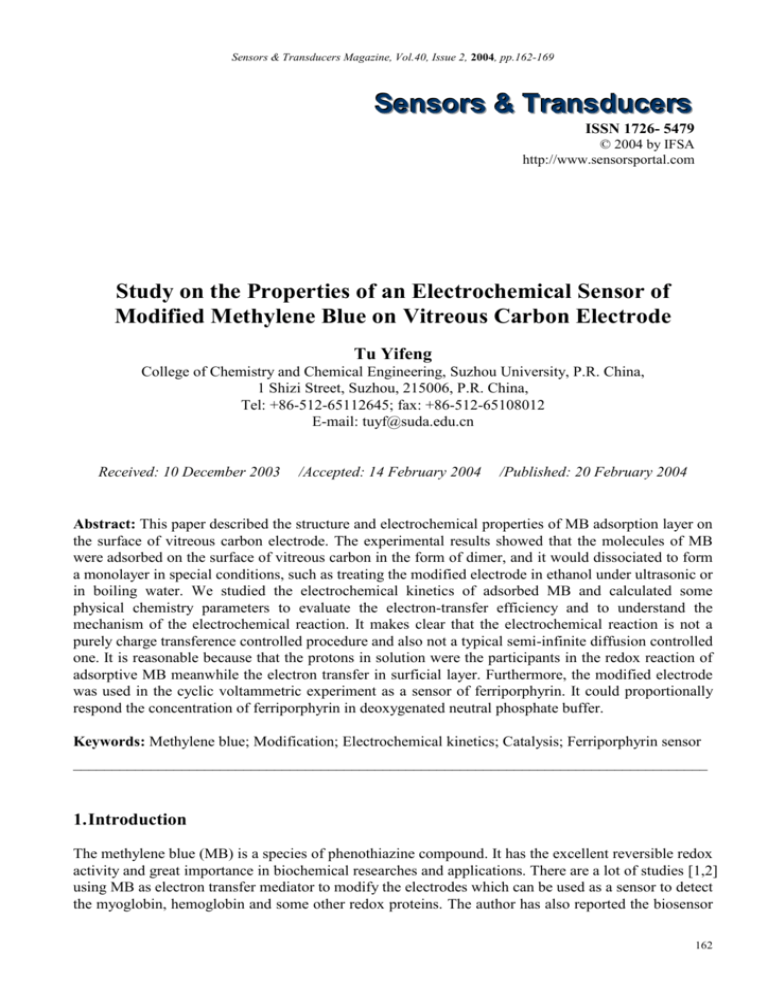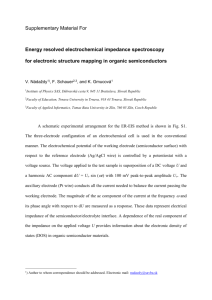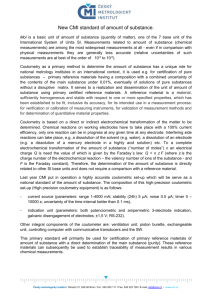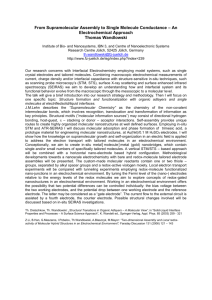
Sensors & Transducers Magazine, Vol.40, Issue 2, 2004, pp.162-169
Sensors & Transducers
ISSN 1726- 5479
© 2004 by IFSA
http://www.sensorsportal.com
Study on the Properties of an Electrochemical Sensor of
Modified Methylene Blue on Vitreous Carbon Electrode
Tu Yifeng
College of Chemistry and Chemical Engineering, Suzhou University, P.R. China,
1 Shizi Street, Suzhou, 215006, P.R. China,
Tel: +86-512-65112645; fax: +86-512-65108012
E-mail: tuyf@suda.edu.cn
Received: 10 December 2003
/Accepted: 14 February 2004
/Published: 20 February 2004
Abstract: This paper described the structure and electrochemical properties of MB adsorption layer on
the surface of vitreous carbon electrode. The experimental results showed that the molecules of MB
were adsorbed on the surface of vitreous carbon in the form of dimer, and it would dissociated to form
a monolayer in special conditions, such as treating the modified electrode in ethanol under ultrasonic or
in boiling water. We studied the electrochemical kinetics of adsorbed MB and calculated some
physical chemistry parameters to evaluate the electron-transfer efficiency and to understand the
mechanism of the electrochemical reaction. It makes clear that the electrochemical reaction is not a
purely charge transference controlled procedure and also not a typical semi-infinite diffusion controlled
one. It is reasonable because that the protons in solution were the participants in the redox reaction of
adsorptive MB meanwhile the electron transfer in surficial layer. Furthermore, the modified electrode
was used in the cyclic voltammetric experiment as a sensor of ferriporphyrin. It could proportionally
respond the concentration of ferriporphyrin in deoxygenated neutral phosphate buffer.
Keywords: Methylene blue; Modification; Electrochemical kinetics; Catalysis; Ferriporphyrin sensor
__________________________________________________________________________________
1. Introduction
The methylene blue (MB) is a species of phenothiazine compound. It has the excellent reversible redox
activity and great importance in biochemical researches and applications. There are a lot of studies [1,2]
using MB as electron transfer mediator to modify the electrodes which can be used as a sensor to detect
the myoglobin, hemoglobin and some other redox proteins. The author has also reported the biosensor
162
Sensors & Transducers Magazine, Vol.40, Issue 2, 2004, pp.162-169
[3] based on the use of MB as mediator. But there is not sufficient understanding of behavior and
properties of adsorbed MB although relevant documents had described its behavior in aqua solution as
dimmer [4] and its adsorption on the surface of mercury electrode [5] or vitreous carbon electrode [6].
This paper will report some new results about the structure, electrochemical properties, and the
adsorption behavior of MB on the surface of vitreous carbon electrode. These results show that the
molecules of MB were adsorbed on the surface of vitreous carbon electrode as the dimer but it would
dissociate to form the monolayer in special conditions such as treating in ethanol under ultrasonic or
boiling water.
Furthermore, there are also discussions in details on the electrochemical characters of MB adsorption
layer. Some kinetic parameters were evaluated and the mechanism of electrochemical reaction of this
adsorption layer was presented. Also the response of this sensor for ferriporphyrin was studied in this
paper.
2. Experimental
2.1. Instruments and chemicals
A BAS-100A Electroanalyzer (BAS Inc., USA) with a three-electrode cell is used for all of
electrochemical researches. The Ag/AgCl electrode acted as the reference electrode and a Pt wire acted
as the auxiliary electrode. 0.1M (C2H5)4NClO4 supporting electrolyte (deoxygenated by Na2SO3);
1.010-3mol/L MB solution; Ferriporphyrin
2.2. Studies of the adsorption and catalysis of MB on electrode
The surface of vitreous carbon electrode was polished and then washed with ethanol and water in
ultrasonic tank. 5L MB solution was dropped on the surface of electrode when it was dried by airing,
then rinsed by distilled water about 30 seconds later. The volume of MB solution was strictly
controlled to assure that the solution merely covered the carbon surface but not the other part of
electrode. The properties and mechanism of adsorbed MB were studied by several electrochemical
methods. The surficial concentrations of MB were evaluated from the coulometric data of electrolysis
in those experiments the real surficial area of electrode was previously calibrated with saturated
adsorption of anthraquinone. The cyclic voltammetric scan within the potential range from -0.5V to
+0.5V (vs. Ag/AgCl) could provide the informations about the relationships between peak current,
peak potential, half peak width and correlate factors, and subsequently be used in studies of the
electrochemical and relevant physical chemical characteristics. The electron transference and the rate
controlling step of MB adsorbed layer were studied by both chronoamperometry and potential step
chronoamperometry. Finally, the sensor was used to proceed to the studies on the catalysis for the
oxidation of ferriporphyrin.
3. Results and discussion
3.1. The structure of adsorptive methylene blue on vitreous carbon electrode
The real surficial area of the mechanical polished vitreous carbon electrode (its geometric area is
9.010-2 cm2) was determined by chronocoulometry or bulk electrolysis. The quantity of coulombs of
163
Sensors & Transducers Magazine, Vol.40, Issue 2, 2004, pp.162-169
anthraquinone monosulfonate saturated adsorption layer on its surface was determined for 6.32 C.
According to reported surficial concentration of anthraquinone [7] on vitreous carbon electrode
(1.1010-10 mol/cm2), the real surficial area could be evaluated for 0.298 cm2. Therefore, the surficial
concentration of MB (T) has been determined for 2.9710-10 mol/cm2. Meaningfully, it would
decrease to 1.6810-10 mol/cm2 if treating the electrode with ethanol in ultrasonic wave or boiling in
distilled water for enough time. The grams of dependance of peak current on treating time and the
alteration of half peak width (EFWHM) during the treating procedure were shown in Fig. 1 and Fig. 2.
The aforementioned facts show obviously that the adsorptive layer on electrode surface is impossible
of a monomer layer. The initial adsorptive concentration of MB on electrode surface is about twice
over the usual surficial concentrations of saturated adsorptive monolayer of other molecules, and the
evidence also come from the half peak width, which depends on the structure of adsorption layer [8].
Assuming that MB was adsorbed on electrode surface as dimer, the explanation of its behavior would
be satisfactory. The treating with ethanol or boiling water might lead to the dissociation of dimer so
that the surficial concentration decreased for about one half. The distinct change of half peak width
could also reveal the obvious variations of surface activity coefficients rO and rR that were attributed to
the alternation of repulsive interaction among the adsorbed molecules during the dissociation process.
20
16
ip / A
12
8
4
0
0
1
2
3
4
5
Time / min.
Fig. 1: Dependance of peak current on treating time
164
Sensors & Transducers Magazine, Vol.40, Issue 2, 2004, pp.162-169
200
EFWHM / mV
190
180
170
160
0.0
0.5
1.0
1.5
2.0
2.5
3.0
treating time / min.
Fig. 2: Dependance of EFWHM on treating time
Furthermore, the constant of surface electron transfer rate k was also evaluated according to the method
that was reported in literature [9] and its logarism is linearly related to the reciprocal value of
temperature (see Fig.3). It obeys the Arrhenius’ equation, so the activation energy of cathodic and
anodic processes could be evaluated for 26.6Kj/mol and 57.2Kj/mol. Refer to the literature [10] which
reported the structure of MB dimer in aqueous as a sandwich with the overlapped molecular plane and
oppositely paralleled principal molecular axis, and the standard free energy for 21.34 Kj/mol, the
difference of the activation energies between the cathodic and anodic processes can be thought of just
right to overcome the repulsive force between the charged amino groups to form the dimer in which
the charged groups lie along the opposite edges of sandwich. So the structure of adsorbed MB dimers
could be inferred as an ordered arrangement and its reductive molecules (leuco MB) would unordered
rearranged due to there were not any charges. These dimers would dissociate under the ultrasonic
condition in ethanol or boiling in water, therefore the adsorption layer must be a monolayer.
3.2. The kinetics of electrochemical reaction
From above discussion, the electrochemical reaction of MB on the surface of vitreous carbon electrode
could be expressed as follows:
(MB+)2 + 4e + 2H+
(MB)2
The voltammetric peak potentials of electrochemical redox reaction were correlative with the scan rate
as the curves in Fig.4. The coefficients of electron transfer [11] of adsorption layer were evaluated
from the slope of curves for 0.71 and 0.76 corresponding the reduction and oxidation process
respectively, and they decreased to 0.11 and 0.21 if the scan rate was higher than 500 mV/S. These
facts show that the electron transfer in adsorption layer is a relatively slow process. It isn’t so easy to
transfer the electrons between two molecules because of the gap of the electroactive centers of two
molecules in MB dimer.
165
Sensors & Transducers Magazine, Vol.40, Issue 2, 2004, pp.162-169
1
0
-1
b
ln k
-2
-3
-4
-5
a
-6
2.8
3.0
3.2
3.4
3.6
3.810-3
1/T
Fig. 3: The Arrhenius Curves of (a) oxidation process and (b) reduction process
Ep / mV
300
a
200
100
b
0
-4
-2
ln
0
2
Fig. 4: The relationship between Ep and ln
(a) oxidation process and (b) reduction process
The i-t-1/2 curve was drawn by the results of chronoamperometric experiments (see Fig.5). The
Dct1/2C[12,13] (there the Dct is the charge transfer diffusion coefficient and the C is the concentration
of electroactive centers in electrode surficial layer) could be evaluated from the slope of this curve for
3.110-10 mol/cm2s1/2 and therefore the Dct /d2 was evaluated for 1.09. This datum makes clear that
the electrochemical reaction is not a purely charge transference or a typical semi-infinite diffusion
166
Sensors & Transducers Magazine, Vol.40, Issue 2, 2004, pp.162-169
controlled procedure. More evidences from the CV characters of the MB adsorptive layer support the
aforementioned standpoint. All the peak currents (ip(c), ip(a)) and the difference of peak potentials (Ep)
are linearly related to the square root of scan rate (1/2) (see Fig.6, 7) but not . It do not accord with
the well known CV characters of thin film that the peak currents are proportional to and the Ep is
approach to zero, but agree with the diffusion controlled procedure [14,15] that ip is proportional to 1/2.
The reasonable cause is that the protons in solution were the participants in the redox reaction of
adsorptive MB layer meanwhile the electron transfer in surficial layer.
6
4
2
0
0.0
1.0
2.0
-1/2
t
/s
3.0
-1/2
Fig. 5: The Cotrell curve
ip(a)
15
12
ip / A
i /A
8
ip(c)
9
6
3
0
0.1
0.2
0.3
1/2
0.4
0.5
/ V S
1/2
-1/2
Fig. 6: The curve of ip~1/2
167
Sensors & Transducers Magazine, Vol.40, Issue 2, 2004, pp.162-169
Ep / V
0.4
0.2
0.0
0.0
0.5
1.0
1.5
2.0
2.5
1/2 / V1/2S-1/2
Fig. 7: The curve of Ep~1/2
3.3. The response of the sensor for ferriporphyrin
The sensor was used in the cyclic voltammetric experiment as a working electrode. It could catalyze
the oxidation of ferriporphyrin in deoxygenated neutral phosphate buffer. The anodic peak current of
the sensor proportionally responded the concentration of ferriporphyrin, it could be see in Fig. 8.
Fig. 8: The response of MB modified electrode on the concentration of ferriporphyrin
168
Sensors & Transducers Magazine, Vol.40, Issue 2, 2004, pp.162-169
References
[1] Ye Jiannong and R.P.Baldwin, Anal. Chem., 60 (1988) 2263.
[2] Ju Huangxian, Xun Yigang and Chen Hongyuan, Chem. J. Chinese University, 15(1994) 827.
[3] Tu Yifeng, Anal. Lab., 16(supplement)(1997) 12.
[4] P.J.Hillson and R.B.McKay, Trans. Faraday Soc., 61 (1965) 374.
[5] F.Pergola, G.Piccardi and R.Guidelli, J. of Electroanal. Chem., 83 (1977) 33.
[6] A.A.Karyakin, A.K.Strakhova, E.E.Karyakina et al., Bioelectrochem. Bioenerg., 32 (1993) 350.
[7] A.P.Brown and F.C.Anson, Anal.Chem., 49 (1997) 1589.
[8] R.W.Murray, in Electroanalytical Chemistry, Vol.13, p.191, A.J.Bard, Ed., Marcel Dekker, New York,
1984.
[9] M.Sharp and M.Petersson, J. Electroanal. Chem., 122 (1981) 409.
[10]K.Bergmann and C.T.O’Konski, J. Phys. Chem., 67 (1963) 2169.
[11]E.Laviron, J. Electroanal. Chem., 101 (1979) 29.
[12]P.Denisevich, H.D.Abruna, C.R.Leidner, T.J.Meyer and R.W.Murry, Inorg. Chem., 21 (1982) 2153.
[13]P.Daum, J.R.Lenhard, D.R.Rolison, R.W.Murray, J. Am. Chem. Soc., 102 (1980) 4649.
[14]E.Laviron, J.Electroanal. Chem.,100 (1979) 263.
[15]H.Angerstein-Kozlowska, J.Klinger, B.C.Conway, J. Electroanal. Chem., 75 (1977) 45.
___________________
2004 Copyright ©, International Frequency Sensor Association (IFSA). All rights reserved.
(http://www.sensorsportal.com)
169







